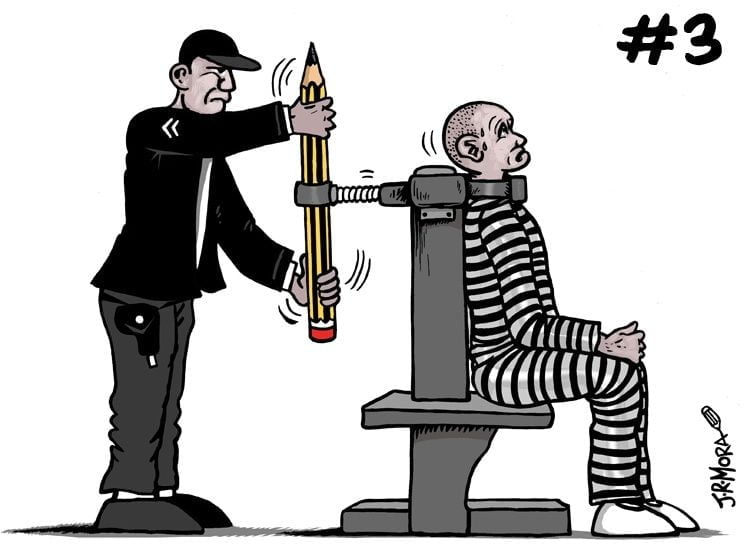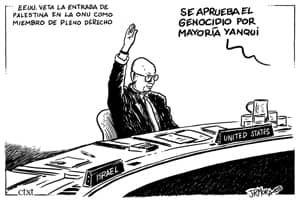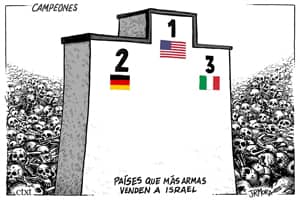
TR: "How dare Israel attack civilians..." Michael Ramirez cartoon published on 8 November.
There is another war going on in editorial cartoons, one that provokes clashes to dominate what they call the "story" and in which many battles are fought, even if we only know a few of them.
If in October the British daily The Guardian avoided publishing a cartoon featuring Netanyahu and finally fired its cartoonist, and shortly afterwards the US daily The Aspen Times apologised to its readers for publishing this cartoon by its cartoonist, now it is the Washington Post that withdraws a cartoon by Michael Ramírez (1961) entitled "Human Shields" and apologises.
The Washington Post's opinion editor published a note, heading the letters of complaint from readers who called it racist and derogatory, in which he "regrets" having approved the cartoon by Michael Ramirez, winner of two Pulitzer Prizes, in which the use of human shields by Hamas was pointed out.
Editor’s note: As editor of the opinion section, I am responsible for what appears in its pages and on its screens. The section depends on my judgment. A cartoon we published by Michael Ramirez on the war in Gaza, a cartoon whose publication I approved, was seen by many readers as racist. This was not my intent. I saw the drawing as a caricature of a specific individual, the Hamas spokesperson who celebrated the attacks on unarmed civilians in Israel.
However, the reaction to the image convinced me that I had missed something profound, and divisive, and I regret that. Our section is aimed at finding commonalities, understanding the bonds that hold us together, even in the darkest times.
In this spirit, we have taken down the drawing. We are also publishing a selection of responses to the caricature. And we will continue to make the section home to a range of views and perspectives, including ones that challenge readers. This is the spirit of opinion journalism, to move imperfectly toward a constructive exchange of ideas at all possible speed, listening and learning along the way.
-David Shipley, Opinion Editor
Letters from readers*
*These are just a few samples, many more have been received and published.
The Nov. 8 editorial cartoon has been perceived as deeply malicious and offensive by a considerable number of readers, including me.
The caricatures employ racial stereotypes that were offensive and disturbing. Depicting Arabs with exaggerated features and portraying women in derogatory, stereotypical roles perpetuates racism and gender bias, which is wholly unacceptable.
The essence of responsible journalism lies in its ability to give voice to those who might not have one, to champion transparency and to promote informed dialogue. When content is published that contradicts these principles, it raises legitimate questions about the editorial processes, integrity and reliability.
Hind Kamal, Fairfax
There is no topic in reporting in which word choice is as fraught as in reporting on the Gaza Strip. Why does The Post not subject the visual language of its cartoons to the same scrutiny?
I am a scholar of religion and media; I recognize a deeply racist depiction of the “heathen” and his barbarous cruelty toward women and children when I see it again in Michael Ramirez’s Nov. 8 editorial cartoon. It is in no way informative, helpful or thought-provoking to look at this conflict through the glasses of 19th-century colonialists.
Suzanne van Geuns, Princeton, N.J.
The writer is a postdoctoral research associate at the Center for Culture, Society and Religion at Princeton University.
Michael Ramirez’s Nov. 8 editorial cartoon depicted a Hamas representative tying women and children to himself to use as human shields, then blaming Israel for their deaths. Though no one disputes that Hamas hides in civilian areas to evade the Israeli army, this cartoon amounted to an attempt at excusing Israeli war crimes.
Every major human rights organization has accused Israel of committing war crimes with its massive and indiscriminate bombing campaigns of civilian areas. So, thousands of Palestinian children are getting killed, not because Israel is making a pinpointed effort to kill Hamas and failing but because Israel is making no meaningful effort to spare civilians.
The Israeli military also has a documented record of using Palestinian civilians as human shields and has protested the Israeli Supreme Court’s 2005 ban of the practice. Even after the ban, the Israeli military still occasionally used Palestinian children as human shields.
In light of all this, laying the deaths of Palestinian civilians at the feet of Hamas instead of the people actually killing them is a gross mischaracterization of the situation.
Omar Baddar, Washington
Michael Ramirez’s Nov. 8 editorial cartoon depicting Hamas hostages with the Hamas character condemning Israeli attacks on civilians was full of bias and prejudice.
Is the message meant to be that Israel is justified in bombing civilians? And is the Palestinian flag on one side of the cartoon meant to conflate Hamas with all Palestinians? And is the background photo — on the other side of the cartoon, of the Dome of the Rock meant to conflate Hamas ideology with Islam? Ramirez ought to have thought about these elements in the cartoon. They are offensive not only to Muslims, but to me and all of my Palestinian Christian sisters and brothers.
Philip Farah, Vienna
The writer is a co-founder and board member of the Palestinian Christian Alliance for Peace.
As The Print points out, this is not the first time Ramirez has pissed off the staff this month with his work.
In a cartoon, published on 3 November in the Las Vegas Review-Journal, he attacked the Black Lives Matter movement in the United States protesting the death of African-American George Floyd at the hands of police officers. In his cartoon, Ramirez depicted a black woman in a Black Lives Matter T-shirt, holding a sign that reads "Terrorist Lives Matter" and "Blame Israel. Support Hamas".
Humour in trouble, collection of cases (III)
Cases of cartoonists who have had problems of some importance because of their cartoons or satirical illustrations. There are also some stories of other people who, without being cartoonists, have got into trouble for sharing them.








